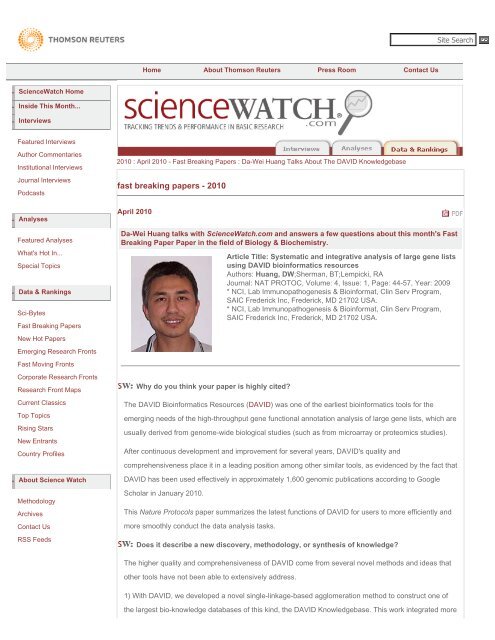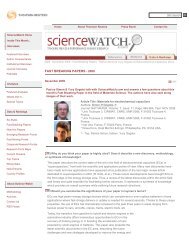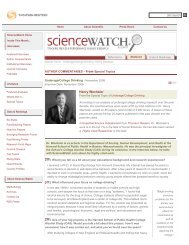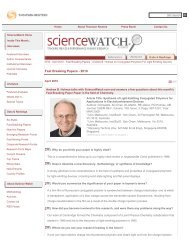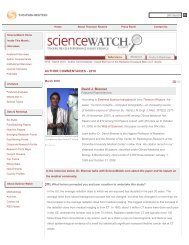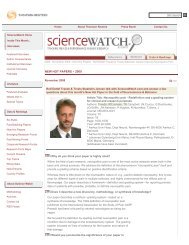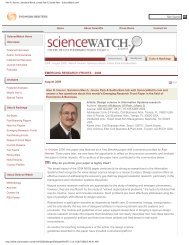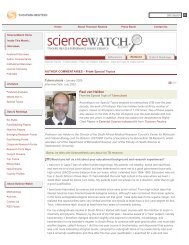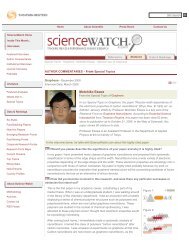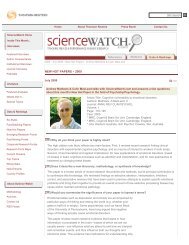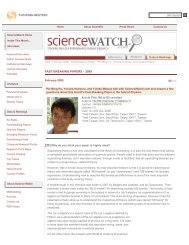Systematic and integrative analysis of large gene lists
Systematic and integrative analysis of large gene lists
Systematic and integrative analysis of large gene lists
You also want an ePaper? Increase the reach of your titles
YUMPU automatically turns print PDFs into web optimized ePapers that Google loves.
Home About Thomson Reuters Press Room Contact Us<br />
●<br />
●<br />
●<br />
ScienceWatch Home<br />
Inside This Month...<br />
Interviews<br />
Featured Interviews<br />
Author Commentaries<br />
Institutional Interviews<br />
Journal Interviews<br />
Podcasts<br />
2010 : April 2010 - Fast Breaking Papers : Da-Wei Huang Talks About The DAVID Knowledgebase<br />
fast breaking papers - 2010<br />
●<br />
●<br />
●<br />
Analyses<br />
Featured Analyses<br />
What's Hot In...<br />
Special Topics<br />
Data & Rankings<br />
Sci-Bytes<br />
Fast Breaking Papers<br />
New Hot Papers<br />
Emerging Research Fronts<br />
Fast Moving Fronts<br />
Corporate Research Fronts<br />
Research Front Maps<br />
Current Classics<br />
Top Topics<br />
Rising Stars<br />
New Entrants<br />
Country Pr<strong>of</strong>iles<br />
About Science Watch<br />
Methodology<br />
Archives<br />
Contact Us<br />
RSS Feeds<br />
April 2010<br />
Da-Wei Huang talks with ScienceWatch.com <strong>and</strong> answers a few questions about this month's Fast<br />
Breaking Paper Paper in the field <strong>of</strong> Biology & Biochemistry.<br />
Why do you think your paper is highly cited?<br />
Article Title: <strong>Systematic</strong> <strong>and</strong> <strong>integrative</strong> <strong>analysis</strong> <strong>of</strong> <strong>large</strong> <strong>gene</strong> <strong>lists</strong><br />
using DAVID bioinformatics resources<br />
Authors: Huang, DW;Sherman, BT;Lempicki, RA<br />
Journal: NAT PROTOC, Volume: 4, Issue: 1, Page: 44-57, Year: 2009<br />
* NCI, Lab Immunopatho<strong>gene</strong>sis & Bioinformat, Clin Serv Program,<br />
SAIC Frederick Inc, Frederick, MD 21702 USA.<br />
* NCI, Lab Immunopatho<strong>gene</strong>sis & Bioinformat, Clin Serv Program,<br />
SAIC Frederick Inc, Frederick, MD 21702 USA.<br />
The DAVID Bioinformatics Resources (DAVID) was one <strong>of</strong> the earliest bioinformatics tools for the<br />
emerging needs <strong>of</strong> the high-throughput <strong>gene</strong> functional annotation <strong>analysis</strong> <strong>of</strong> <strong>large</strong> <strong>gene</strong> <strong>lists</strong>, which are<br />
usually derived from genome-wide biological studies (such as from microarray or proteomics studies).<br />
After continuous development <strong>and</strong> improvement for several years, DAVID's quality <strong>and</strong><br />
comprehensiveness place it in a leading position among other similar tools, as evidenced by the fact that<br />
DAVID has been used effectively in approximately 1,600 genomic publications according to Google<br />
Scholar in January 2010.<br />
This Nature Protocols paper summarizes the latest functions <strong>of</strong> DAVID for users to more efficiently <strong>and</strong><br />
more smoothly conduct the data <strong>analysis</strong> tasks.<br />
Does it describe a new discovery, methodology, or synthesis <strong>of</strong> knowledge?<br />
The higher quality <strong>and</strong> comprehensiveness <strong>of</strong> DAVID come from several novel methods <strong>and</strong> ideas that<br />
other tools have not been able to extensively address.<br />
1) With DAVID, we developed a novel single-linkage-based agglomeration method to construct one <strong>of</strong><br />
the <strong>large</strong>st bio-knowledge databases <strong>of</strong> this kind, the DAVID Knowledgebase. This work integrated more
than 40 well-known functional annotation categories from dozens <strong>of</strong> public databases, thereby providing<br />
a solid foundation for DAVID data-mining algorithms.<br />
2) We developed a set <strong>of</strong> novel fuzzy-logic algorithms to address the redundant<br />
relationships among many-<strong>gene</strong>s-to-many-terms. This work can make the annotation<br />
results more focused <strong>and</strong> cleaner by reducing the redundancy <strong>and</strong> repeats.<br />
3) We created a unique memory-based data IO method to enhance calculating speed<br />
more than 10 times faster than the method based on database query.<br />
Would you summarize the significance <strong>of</strong> your paper in layman's terms?<br />
The modern high-throughput technologies, such as <strong>gene</strong> chip, allow investigators to<br />
simultaneously measure the changes <strong>of</strong> genome-wide <strong>gene</strong>s under certain diseases<br />
(e.g., cancer vs. normal).<br />
"...to the best<br />
<strong>of</strong> my<br />
knowledge,<br />
the paper<br />
provides the<br />
clearest<br />
principles<br />
<strong>and</strong><br />
guidelines<br />
for genomics<br />
researchers<br />
to conduct<br />
data <strong>analysis</strong><br />
<strong>of</strong> this kind."<br />
After hundreds or even thous<strong>and</strong>s <strong>of</strong> <strong>gene</strong>s with changes are able to be identified,<br />
biological interpretation <strong>of</strong> them is an important <strong>and</strong> necessary downstream step for investigators to<br />
underst<strong>and</strong> the biological mechanisms <strong>of</strong> the diseases they are studying (e.g., cancer).<br />
The Nature Protocols paper describes both underlying analytical principles <strong>and</strong> step-by-step procedures<br />
to interpret biological mechanisms from the results derived from the high-throughput technologies.<br />
How did you become involved in this research, <strong>and</strong> were there any problems along the way?<br />
I had obtained extensive h<strong>and</strong>s-on bioinformatics experience, particularly in the areas <strong>of</strong> high-throughput<br />
DNA sequencing <strong>and</strong> microarray, through a couple <strong>of</strong> jobs in biotech companies since 2000. I had<br />
almost decided my next move would be to a pharmaceutical company, Eli Lilly, in the summer <strong>of</strong> 2004.<br />
In the end, I decided to move back to an academic R&D environment to lead the DAVID Bioinformatics<br />
Lab at NIH/SAIC-Frederick, the operations <strong>and</strong> technical support contractor for NCI. After joining <strong>and</strong><br />
leading the DAVID Bioinformatics lab, I realized that I had made the right decision because I completely<br />
fell in love with the DAVID project as proposed <strong>and</strong> focused by the group.<br />
The DAVID project allows talented team members to fully combine their skills <strong>and</strong> knowledge <strong>of</strong><br />
molecular biology, statistics, <strong>and</strong> computer science. The team efforts eventually turned out nicely, with<br />
the current version <strong>of</strong> DAVID becoming quite popular in the genomic community.<br />
During the R&D course, we had many scientific challenges, which I actually enjoyed very much rather<br />
than thinking <strong>of</strong> them as problems. I found that it is indeed a challenging <strong>and</strong> difficult task to coordinate<br />
activities, goals, <strong>and</strong> projects across inter-disciplinary lines, with molecular biologists, computer<br />
programmers, <strong>and</strong> statisticians all as members <strong>of</strong> the same team. Since bioinformatics represents a<br />
joining <strong>of</strong> these areas, it seems that I will have to face such challenges during day-to-day project<br />
management for the rest <strong>of</strong> my pr<strong>of</strong>essional life.<br />
Where do you see your research leading in the future?<br />
The next <strong>gene</strong>ration <strong>of</strong> high-throughput technologies is moving toward measurements <strong>of</strong> finer biological<br />
elements from <strong>gene</strong> intensity level, such as ChIP-on-chip to measure promoter activities, SNP<br />
microarray to measure <strong>gene</strong>tic l<strong>and</strong> markers, <strong>and</strong> exon microarray to measure alternative splicing<br />
events.
We will exp<strong>and</strong> DAVID functions to align with the analytical needs <strong>of</strong> the newer technologies, which<br />
needs are still unmet in the genomic community.<br />
Do you foresee any social or political implications for your research?<br />
Although my work does not have political impact, some aspects <strong>of</strong> social implications are <strong>of</strong> immediate<br />
application. For example, to the best <strong>of</strong> my knowledge, the paper provides the clearest principles <strong>and</strong><br />
guidelines for genomics researchers to conduct data <strong>analysis</strong> <strong>of</strong> this kind.<br />
Da-Wei Huang, M.D.<br />
Supervisor, DAVID Bioinformatics Lab<br />
Laboratory <strong>of</strong> Immunopatho<strong>gene</strong>sis <strong>and</strong> Bioinformatics<br />
Clinical Services Program<br />
SAIC-Frederick, Inc.<br />
National Cancer Institute (NCI) at Frederick<br />
Frederick, MD, USA<br />
KEYWORDS: FUNCTIONAL-ANALYSIS; ONTOLOGY; TOOL; DAVID bioinformatics resources.<br />
back to top<br />
2010 : April 2010 - Fast Breaking Papers : Da-Wei Huang Talks About The DAVID Knowledgebase<br />
Science Home | About Thomson Reuters | Site Search<br />
Copyright | Terms <strong>of</strong> Use | Privacy Policy


